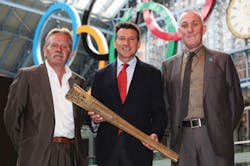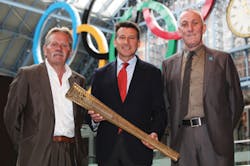Laser cuts and welds the Olympic torch
Coventry, UK - The London 2012 Olympic Torch was manufactured using laser technology by The Premier Group (TPG), a Coventry-based supplier of turnkey engineering and manufacturing solutions for the transport field. TPG used laser machines from Prima Power, the machinery division of the Prima Industrie, to cut the holes and weld the parts of the beautiful icon of the Olympic Games.
One of the most important elements of the Torch, designed by Edward Barber and Jay Osgerby working in partnership with TPG, were the 8,000 holes running the length of the body. These holes were both symbolic and practical: in addition to representing the 8,000 Torchbearers who carried the Olympic Flame on its journey around the UK and at the Olympic Stadium, the holes offered visibility of the internal parts of the Torch and of the burner system which kept the Olympic Flame alive, reduced the Torch's weight, and ensured that heat quickly dissipated without being conducted down the handle. "Because of its symbolic meaning, the number of holes on the Torch was a must," explained Ezio Basso, managing director, Prima Power Division.
Another symbolic element of the Torch was its triangular shape, representing the number 3 with its different meanings linked to the Games: the three Olympic values (Respect, Excellence, and Friendship); the three words that comprise the Olympic motto (Faster, Higher, Stronger); and the three times the Olympic Games have been held in the UK.
The Torch's unique shape was obtained from aluminum sheet metal blanks cut by Premier and formed using a special pressing tool. Aluminum is widely used in the automotive and aerospace industries because it is lightweight and has good tensile strength and heat resistance - this made the torch lightweight and strong. The Premier Group laser-welded the parts of the Torch together in a smooth, seamless joint, and laser-cut the holes into the welded areas.
Both welding and cutting operations on the Torch after it was formed were performed by Prima Power Optimo 3D laser machine with Vivida technology. This machine can be easily converted from cutting to welding through a quick change of the head attachment, so a single machine is used for different applications.
This Update item was adapted, with permission, from an article that previously appeared in the Prima Power publication Powerline.

